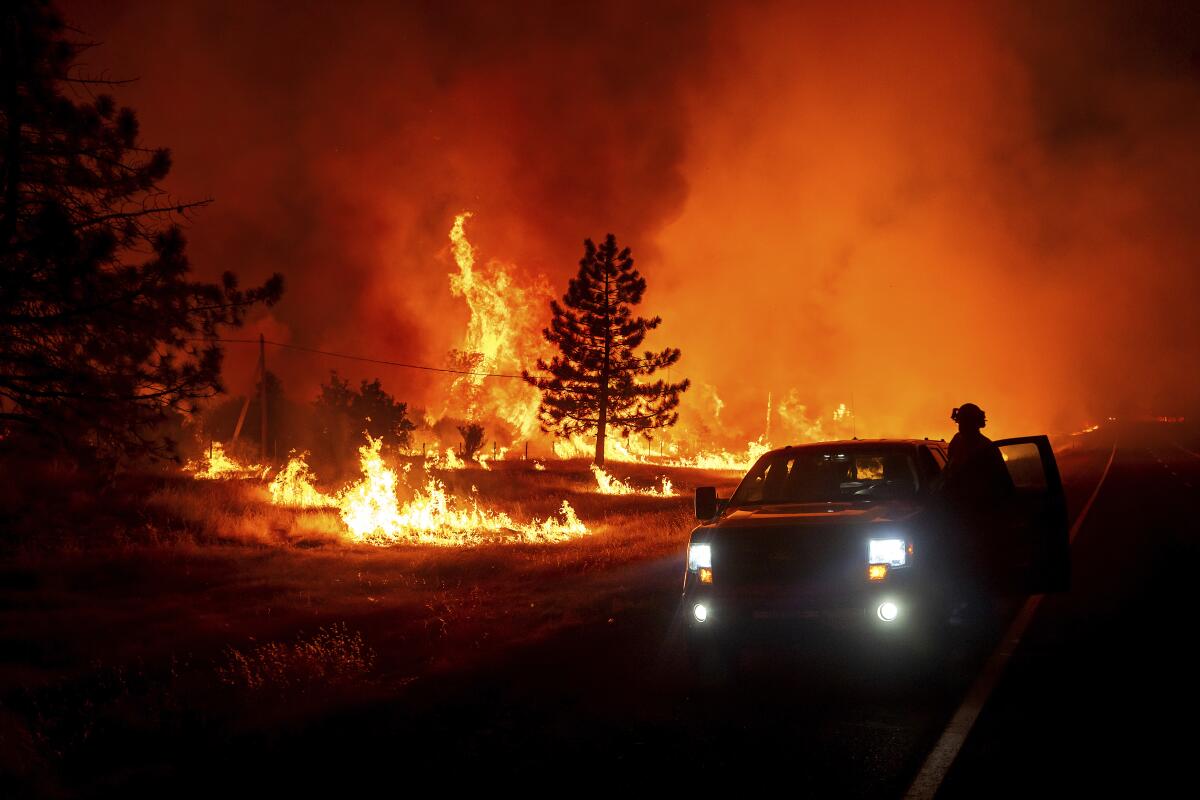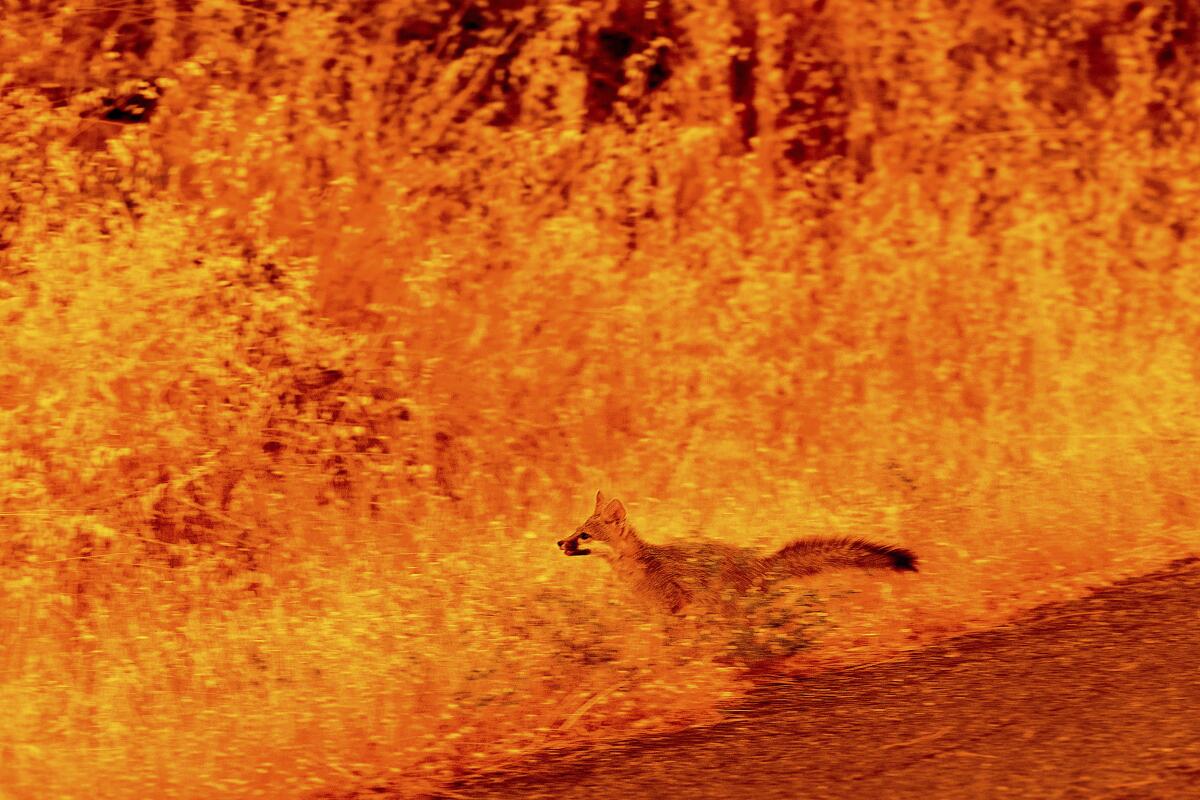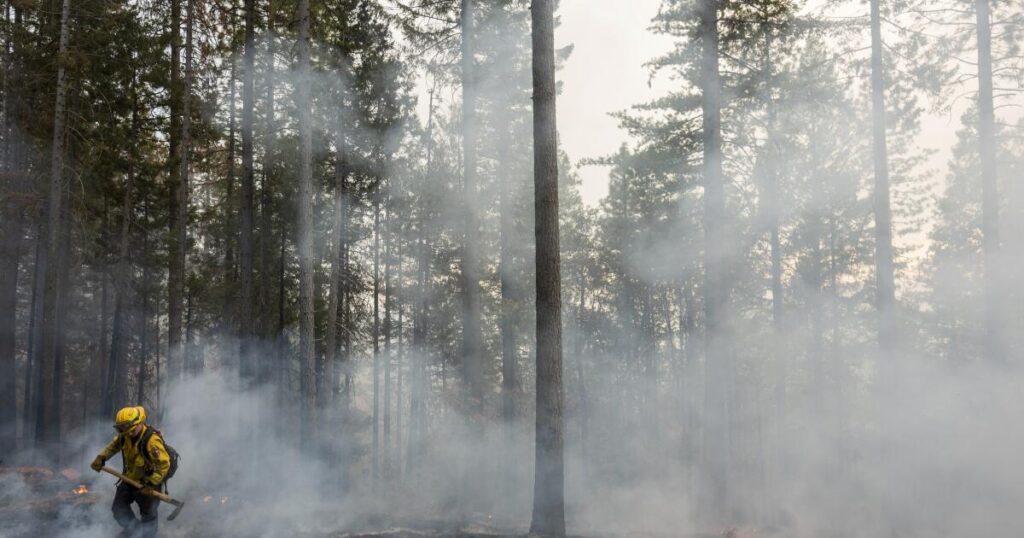Firefighters were responding to rapidly changing conditions on Sunday while battling the Park Fire in Butte, Plumas, Shasta and Tehama counties, the largest wildfire in California this year and the seventh-largest ever in the state. fire.
The 360,141-acre blaze was 12% contained due to a brief break in hot, dry weather conditions over the weekend, but the fires flared up again in multiple locations on Sunday and caused some “pretty significant spread,” according to Cal Fire. .
“We are seeing an increase in fire activity during this afternoon’s incident,” Chief of Operations Mark Brenton told an afternoon press conference.
Crews will continue to face an uphill battle this week as the fires continue to burn through dense vegetation, with rising temperatures and falling humidity on the horizon.
“We’re influenced to some extent by weather, fuels and terrain – those are the three driving factors for any fire,” said Jay Tracy, a spokesman for the event.

The Park Fire was raging as it spread to Highway 36 near Paynes Creek in Tehama County on Friday.
(Noah Berger/AP)
A man pushed a burning car into a ravine near Chico Wednesday afternoon in what authorities said was an act of arson, sparking an explosive wildfire. Approximately 4,200 people have been evacuated from their homes, at least 67 buildings have been destroyed, and 4,200 structures remain under threat.
More than 4,000 firefighters are fighting the blaze from the air and on the ground. But Tracy said the fires are burning in steep, jagged terrain that is difficult to access, including areas like the Ish Wilderness that haven’t burned in decades and are therefore overgrown and fire-prone.
“There’s no infrastructure there to provide the roads and access points we need,” he added.
The fire is spreading mainly northeast, with communities like Paynes Creek remaining areas of greatest concern. Officials said the fire has also spread to Deer Creek, Lomo and other areas along Highway 32 and is moving into some thicker vegetation.
“We’ve had some challenges along Corridor 32,” Cal Fire Incident Commander Billy See said at a news conference.
Chico fire expert and geographer Zeke Lund said another community of concern — Cohasset on the fire’s southern perimeter — has so far not been spared due to a combination of “luck and hard work.”
Lund said during a Saturday evening briefing that satellite images of the fires captured by the European Space Agency show many active heat sources and flame spots, but also show some beneficial forest management and fuel reduction projects that are helping Protect some areas.
Most evacuation orders remain in effect, but some were downgraded to warnings Sunday afternoon, including in the Rock Creek and Richardson Springs areas.
However, forecasters say that luck could soon change. Sara Purdue, a meteorologist with the National Weather Service in Sacramento, said that while a low-pressure system brought significantly cooler and wetter conditions to the region over the weekend, the coming days will likely bring gradually warmer temperatures and lower humidity. .
“We are looking at the potential to hit triple digits next weekend,” Purdue said. “There is still some uncertainty in the forecast, but it will be a slow transition to above-normal temperatures.”
The fires prompted Gov. Gavin Newsom to declare a state of emergency, and he said Saturday that he had secured additional federal aid to help fight the blazes.
“This is already one of the largest fires in California history, and we continue to see dangerous conditions – and our firefighters and emergency responders are working around the clock to protect our communities,” Newsom said in a statement. Californians must heed warnings from local authorities and take steps to stay safe. “
In fact, the Park Fire is far from the only fire in California, where crews are battling more than two dozen active wildfires.
In Kern County, the Borel Fire has burned more than 38,000 acres and was 0% contained Sunday, according to Capt. Andrew Freeborn of the Kern County Fire Department.
He said the fire started Wednesday in the Kern River Gorge and spread quickly as it moved through the canyon and encountered strong winds along the ridge.
“We are on a red flag warning and the fire continues to burn in a very, very intense and erratic manner,” Freeborn said. “The flames can be seen from miles away. If you’re wondering what the definition of extreme fire behavior is What, we saw that in this fire.
Evacuation orders and warnings were issued throughout the region. Freeborn said structural damage was still being assessed; however, there was significant structural damage in the historic mining town of Hawera.
The Borel Fire is being managed along with two other fires in Kern and Tulare counties, collectively known as SQF lightning events. Other fires include the Trout Fire (23,369 acres burned and 25% contained) and the Long Fire (9,204 acres burned and 35% contained).

An animal runs through the grass as it flees the flames as the Park Fire rips through the Butte County community of Cohasset on Thursday.
(Noah Berger/AP)
Tracy, the park fire spokesman, said some of the extreme behavior in the early days of the fires, such as tornado-like “fire tornadoes” sometimes called “flame tornadoes,” appeared to have slowed down.
But the fires continued to spew large amounts of smoke, with federal smoke maps showing plumes reaching as far away as Oregon and Nevada.
Park fires have closed several roads and Lassen Volcanic National Park has also closed. Evacuation shelters are available at Neighborhood Church in Chico and the Los Molinos Veterinary Hall in Los Molinos. There are also large and small animal shelters in Oroville, Red Bluff and Corning.
Tracy said the battle between weather and firefights will continue in the coming days.
“If the weather continues to cooperate, then we will be able to continue this direct attack and start taking more containment measures,” he said.

